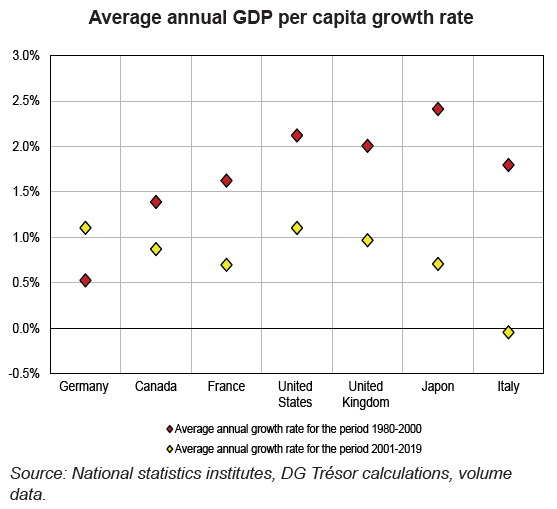Japan's Growth Drivers
Japan’s growth, which was very strong until the 1990s, is now being reined in by ageing capital and a shrinking population. The country is addressing these issues and is banking on an increase in productivity to reignite growth. In this respect, it has significant headroom both as regards the digital transition and in terms of structural changes to the labour market.
After a dazzling economic catch-up in the post-war years, Japan has been experiencing low growth levels since the noughties – which distinguish it within the OECD – despite the efforts of successive governments to generate fresh momentum. Although it posted the highest GDP per capita growth in the G7 until the end of the 1990s, Japan, together with Italy, is the country in which growth has fallen the most on average since then (see Chart).
Initially buttressed by a rapid rise in capital stock, Japan’s growth has only been sustained by the workforce and total factor productivity since 2010, and this leverage is now weakening. The population is ageing and declining, and hourly labour productivity is growing meekly, especially in SMEs which are predominant in the manufacturing base and are less productive than large enterprises. Too much investment is earmarked to offset capital depreciation – a sign that this factor is poorly allocated. Potential growth, which stood at around 4.0% in 1990, is now estimated at less than 0.5%.
“Abenomics”, which were unveiled in 2013, aimed to expand the workforce and improve working conditions but they were only partly successful. Subsequent governments have focused on investments for the future to boost supply and lastingly lift productivity, through the digital transformation and the low-carbon transition initiated as from 2020, followed by the plan promoting a “new capitalism” which was introduced in 2021 and puts priority on entrepreneurship and vocational training.
Japanese growth will continue to be hampered by demographic trends and this calls for continued support for the employment of older workers, immigration and the birth rate by means of bold structural reforms. Japan also has headroom for improving the allocation of capital and the rollout of new technologies, a sector with strong growth potential.
